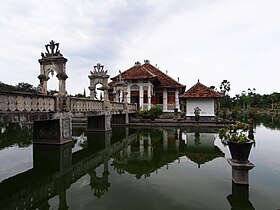
Padangbai is a small coastal town in the Karangasem Regency, in south-eastern Bali, Indonesia. It serves as a ferry port for travel to Lembar on Lombok, The Gilis and other Lesser Sunda Islands.

The Klungkung Palace, officially Puri Agung Semarapura, is a historical building complex situated in Semarapura, the capital of the Klungkung Regency (kabupaten) on Bali, Indonesia.
Gelgel is a village (desa) in the regency (kabupaten) of Klungkung, on Bali, Indonesia. The village, near the coast four kilometers south of the regency capital Semarapura, contains some structures of cultural interest and is known for its pottery and handwoven ceremonial songket cloth.

Pura Ulun Danu Batur is a Hindu Balinese temple located on the island of Bali, Indonesia. As one of the Pura Kahyangan Jagat, Pura Ulun Danu Batur is one of the most important temples in Bali which acted as the maintainer of harmony and stability of the entire island. Pura Ulun Danu Batur represents the direction of the North and is dedicated to the god Vishnu and the local goddess Dewi Danu, goddess of Lake Batur, the largest lake in Bali. Following the destruction of the original temple compound, the temple was relocated and rebuilt in 1926. The temple, along with 3 other sites in Bali, form the Cultural Landscape of Bali Province which was inscribed as a World Heritage Site by UNESCO in 2012.

Tirta Gangga is a former royal palace in eastern Bali, Indonesia, about 5 kilometres from Karangasem, near Abang. Named after the sacred river Ganges in Hinduism, it is noted for the Karangasem royal water palace, bathing pools and its Patirthan temple.

Tirta Empul temple is a Hindu Balinese water temple located near the town of Tampaksiring, Bali, Indonesia. The temple compound consists of a petirtaan or bathing structure, famous for its holy spring water, where Balinese Hindus go to for a ritual purification called Melukat. The temple pond has a spring which gives out fresh water regularly, which Balinese Hindus consider to be holy or amritha. Tirta Empul means Holy Spring in Balinese.

The Dutch intervention in Lombok and Karangasem took place in 1894, and is part of the string of Dutch interventions in and around Bali that led to complete colonization of both Bali and Lombok by the early 20th century.

A Pura is a Balinese Hindu temple and the place of worship for adherents of Balinese Hinduism in Indonesia. Puras are built following rules, style, guidance, and rituals found in Balinese architecture. Most puras are found on the island of Bali, where Hinduism is the predominant religion; however many puras exist in other parts of Indonesia where significant numbers of Balinese people reside. Mother Temple of Besakih is the most important, largest, and holiest temple in Bali. Many Puras have been built in Bali, leading it to be titled "the Island of a Thousand Puras".
Amankila is a luxury coastal hotel situated on the hill of Indrakila, near Manggis in Karangasem Regency in eastern Bali, Indonesia. It is operated by Aman Resorts and was opened in March 1992. The resort is located close to Manggis, Candi Dasa, Tenganan and other villages where traditional crafts are still practiced. Lonely Planet describes Amankila as "one of Bali's best resorts".
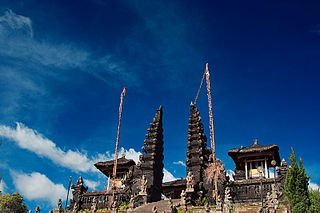
Karangasem Regency is a regency (kabupaten) of the island and province of Bali, Indonesia. It covers the east part of Bali, has an area of 839.54 km2 and had a population of 396,487 at the 2010 Census which rose to 492,402 at the 2020 Census; the official estimate as at mid 2022 was 511,300. Its regency seat is the town of Amlapura. Karangasem was devastated when Mount Agung erupted in 1963, killing 1,900 people. Karangasem was a kingdom before Bali was conquered by the Dutch.
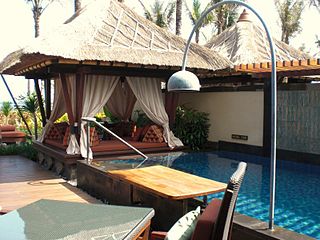
Balinese architecture is a vernacular architecture tradition of Balinese people that inhabits the volcanic island of Bali, Indonesia. Balinese architecture is a centuries-old architectural tradition influenced by Balinese culture developed from Hindu influences through ancient Javanese intermediary, as well as pre-Hindu elements of native Balinese architecture.

Gusti Bagus Djilantik (1887-1966) was the raja of Karangasem Regency in Bali. He served under Dutch East Indies colonial rule. He built the Taman Ujung temple garden. He had the title Anak Agung Agung Anglurah K’tut Karangasem. The park was 400 hectares but was reduced by land reform programs to 10 hectares. The Kingdom's main palace of Puri Amlapura is in Amlapura and dates to the 16th century Balinese prime minister Batan Jeruk.
Pura Griya Sakti is a Balinese Hindu temple located in the village of Manuaba, Kenderan administrative village, Tegalalang subdistrict, Gianyar Regency, Bali. The district is known for its woodcarving and its terraced rice field. The small village of Manuaba is about 4 km north of Kenderan or about 2.5 km southwest of the town of Tampaksiring with its famed Gunung Kawi temple. Pura Griya Sakti is the main temple of a powerful Brahman caste in the area.

Pura Taman Saraswati, officially Pura Taman Kemuda Saraswati, also known as the Ubud Water Palace, is a Balinese Hindu temple in Ubud, Bali, Indonesia. The pura is dedicated to the goddess Sarasvati. Pura Taman Saraswati is notable for its lotus pond.

Pura Goa Lawah is a Balinese Hindu temple or a pura located in Klungkung, Bali, Indonesia. Pura Goa Lawah is often included among the Sad Kahyangan Jagad, or the "six sanctuaries of the world", the six holiest places of worship on Bali. Pura Goa Lawah is noted for being built around the opening of a cave which is inhabited by bats, hence its name, the Goa Lawah or "bat cave".

Pura Penataran Agung Lempuyang is a Balinese Hindu temple or pura located in the slope of Mount Lempuyang in Karangasem, Bali. Pura Penataran Agung Lempuyang is considered as part of a complex of pura surrounding Mount Lempuyang, one of the highly regarded temples of Bali. The temples of Mount Lempuyang, represented by the highest pura at the peak of Mount Lempuyang, Pura Lempuyang Luhur, is one of the Sad Kahyangan Jagad, or the "six sanctuaries of the world", the six holiest places of worship on Bali.

Pura Maospahit is a Balinese Hindu temple or pura located in Denpasar, Bali. The pura is known for its bare red brick architecture, reminiscent of the architecture of the 13th-century Majapahit Kingdom, hence the name. Pura Maospahit is the only pura in Bali which was built using a concept known as Panca Mandala where the most sacred area is situated at the center instead of at the direction of the mountain.
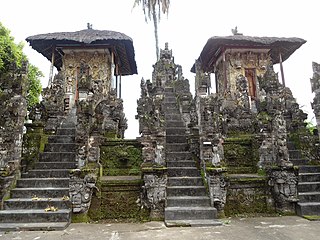
Pura Dalem Segara Madhu also known as Pura Dalem Jagaraga is a northern Balinese Hindu temple or pura located in the village of Jagaraga, Buleleng in northern Bali. It is about 11 km east of Singaraja. The village of Jagaraga is known historically as the place where the Dutch colonial government witnesses puputan or Balinese mass-suicide following their military attack on the kingdom of Bali in 1849. Pura Dalem Segara Madhu is known for its intensive wall decoration typical of northern Balinese architecture and for its unique western-influenced reliefs featuring early 20th-century airplanes and automobiles.

Pura Dasar Buana is a Balinese Hindu temple or pura located in Gelgel, Bali, about 3 kilometres (1.9 mi) from Semarapura. Pura Dasar Buana is one of the Pura Dang Kahyangan Jagat, a temple which was built to honor a holy teacher of Hindu teaching. Pura Dasar Buana honored Mpu Ghana, a Brahmin who arrived to Bali from Javanese Majapahit to teach Hinduism in the island.
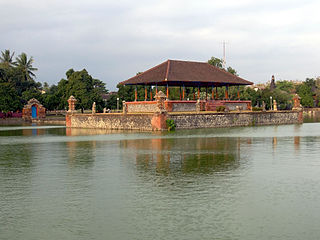
Mayura Park was built by Anak Agung Gde Ngurah Karangasem in 1866, located 2 km east Mataram.



